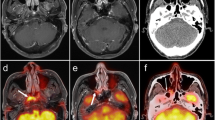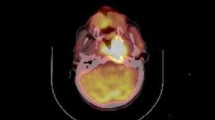Abstract
Objective
We compared positron emission tomography (PET) using 18-fluoro-2-deoxyglucose (FDG), enhanced computed tomography (CT) and magnetic resonance imaging (MRI) in detecting skull base invasion of nasopharyngeal carcinomas (NPC) and to evaluate the value of these three methods in determining the existence of skull base invasion of nasopharyngeal carcinomas.
Methods
The images of enhanced CT, MRI and PET-CT scans, performed at intervals ≤ 20 days on 57 NPC patients from July 2004 to February 2007, were selected and reviewed. The endpoints of the comparison were sensitivity, specificity, accuracy, positive predictive value (PPV) and negative predictive value (NPV) of Enhanced CT, MRI and PET-CT, based on histopathologic findings or clinical imaging follow-up for at least 6 months.
Results
For detecting skull base invasion of NPC, the sensitivity of enhanced CT, MRI and PET-CT were 68.18%, 84.09%, 97.67% respectively; specificity were 76.92%, 69.23%, 57.14% respectively; accuracy were 70.18%, 80.7%, 87.72% respectively; PPV were 90.9%, 90.24%, 87.5% respectively; NPV were 41.67%, 56.25%, 88.89% respectively.
Conclusion
PET-CT has obvious advantages in sensitivity over CT (P < 0.05) and MRI, better than the two methods in accuracy and NPV and may be more valuable for new patients in detecting skull base invasion of NPC patients.
Similar content being viewed by others
References
Wang GH, Lau Eddie WF, Shakher R, et al. Clinical application of 18F-FDG PET/CT to staging and treatment effectiveness monitoring of nasopharyngeal carcinoma. Chin J Cancer (Chinese), 2007, 6: 638–642.
Kao CH, Changlai SP, Chieng PU, et al. Detection of recurrent or persistent nasopharyngeal carcinomas after radiotherapy 18-fluoro — 2-deoxyglucose positron emission tomography and comparison with computed tomography. J Clin Oncol, 1998, 16: 3550–3555.
Chen YK, Su CT, Ding HJ, et al. Clinical usefulness of fused PET/CT compared with PET alone or CT alone in nasopharyngeal carcinoma patients. Anticancer Res, 2006, 26: 1471–1477.
Tsai MH, Shiau YC, Kao CH, et al. Detection of recurrent nasophryngeal carcinomas with positron emission tomography using 18-fluoro-2-deoxyglucose in patients with indeterminate magnetic resonance imaging findings after radiotherapy. J Cancer Res Clin Oncol, 2002, 5: 279–282.
Zeng L, Huang XM, Lu TX, et al. Diagnosis of recurrent or residual nasopharyngeal carcinomas in the skull base area with F-18-Fluro-Dexoxyglucose positron emission tomography. Chin Otolaryngol Head Neck Surg (Chinese), 2006, 7: 517–520.
Greven KM, Williams DW, Mcguirt WF, et al. Serial positron emission tomography scans following radiation therapy of patients with head and neck cancer. Head Neck, 2001, 11: 942–946.
Gil Z, Even-Sapir E, Margalit N, et al. Integrated PET/CT system for staging and surveillance of skull base tumors. Head Neck, 2007, 29: 537–545.
Cheng YZ, Hu CS, Zhou ZR. Comparison of CT and MRI in detecting skull base invasion in nasopharyngeal. Chin Oncol (Chinese), 2005, 2: 167–168.
Author information
Authors and Affiliations
Corresponding author
Rights and permissions
About this article
Cite this article
Ma, X., Ye, M., Liu, T. et al. Comparison of diagnostic value of PET using 18-fluoro-2-deoxyglucose, CT and MRI in detecting skull base invasion of nasopharyngeal carcinomas. Chin. -Ger. J. Clin. Oncol. 8, 456–459 (2009). https://doi.org/10.1007/s10330-009-0105-8
Received:
Revised:
Accepted:
Published:
Issue Date:
DOI: https://doi.org/10.1007/s10330-009-0105-8




